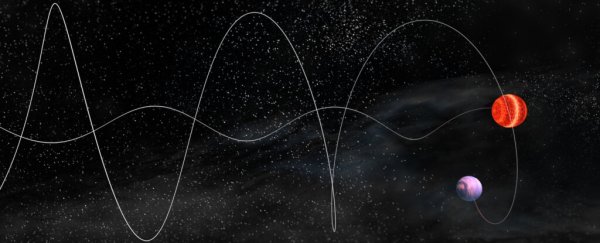The hunt for exoplanets in our galaxy is a deeply important endeavour. The more exoplanets we find, the better we can understand our own Solar System - and how life emerges in the Universe. To date, over 4,000 exoplanets have been confirmed - but a new discovery could widen the search, helping us to find exoplanets that previously have proven too difficult to detect.
The newly discovered exoplanet, with a mass comparable to that of Saturn, orbits a very small, cool red dwarf right at the lower mass limit for main sequence stars, and located about 35 light-years away. However, it's not just the planet, nor the star, that's so groundbreaking here.
What's particularly special in this discovery is how astronomers used a radio telescope to track the movement of the star through the Milky Way, and identify the snaking wiggle in that movement as the star is gravitationally affected by an orbiting exoplanet. This very tricky accomplishment is called the astrometric technique, and it's the first time it's been successfully deployed using a radio telescope.
 Artist's impression of the TVLM 513-46546 system. (Luis A. Curiel Ramirez)
Artist's impression of the TVLM 513-46546 system. (Luis A. Curiel Ramirez)
Using an orbital wobble to detect an exoplanet is not a new idea. You see, the orbital centre of a planetary system isn't in the middle of the star. Rather, all bodies in the system orbit a mutual centre of gravity, called the barycentre. The barycentre of the Solar System, for example, is just outside the surface of the Sun, mainly due to the gravitational influence of Jupiter and Saturn.
When we're looking at other stars with massive, closely orbiting exoplanets, this effect can be detected in the way light wavelengths are stretched or compressed as the star moves around. This detection technique is called Doppler spectroscopy, or the radial velocity method, and it's one of the more common methods for finding exoplanets.
The astrometric technique is a little different. The Milky Way's stars aren't fixed in space; they move around the galaxy, and the study of this movement is called astrometry. So, rather than using changes in wavelengths, the astrometric technique looks for deviations from a straight line of movement.
This method can be used to detect exoplanets that Doppler spectroscopy can't, such as exoplanets circling in larger orbits around their stars.
"Our method complements the radial velocity method, which is more sensitive to planets orbiting in close orbits, while ours is more sensitive to massive planets in orbits further away from the star," said astrophysicist Gisela Ortiz-Leon of the Max Planck Institute for Radio Astronomy in Germany.
"Indeed, these other techniques have found only a few planets with characteristics such as planet mass, orbital size, and host star mass, similar to the planet we found. We believe that the VLBA, and the astrometry technique in general, could reveal many more similar planets."
The VLBA is the Very Long Baseline Array, a network of 10 radio antennas widely distributed across the US. For 18 months starting in June 2018, the research team, led by astronomer Salvador Curiel of the National Autonomous University of Mexico, tracked a small star called TVLM 513-46546 across space for a year and a half.
Painstaking and careful analysis of the data revealed that the star was not travelling in a perfectly straight line, but was travelling more of a snaking path. The periodicity and amplitude of the wiggle revealed a planet on a 221-day orbit, and between 38 and 46 percent of the mass of Jupiter - a little more massive than Saturn, which is around 30 percent of the mass of Jupiter.
"Giant planets, like Jupiter and Saturn, are expected to be rare around small stars like this one, and the astrometric technique is best at finding Jupiter-like planets in wide orbits, so we were surprised to find a lower mass, Saturn-like planet in a relatively compact orbit. We expected to find a more massive planet, similar to Jupiter, in a wider orbit," Curiel said.
The astrometric technique is more commonly used to study binary stars, whose gravitational effect on each other is much more pronounced than the effect of a planet on a star. Only once before has the astrometric technique been used to discover an exoplanet (although it has been used to study already-known exoplanets), and never before with a radio telescope.
Earlier this year, however, another group of scientists announced the first use of a radio telescope to detect an exoplanet. It wasn't through astrometry, but by detecting the circular polarisation of radio waves generated by a planet's movement through a red dwarf's magnetic field.
So, although the detection was quite challenging for Curiel's team, their ultimate success confirms the promise of both radio telescopes and the astrometric technique in finding planets that other techniques miss.
The Gaia telescope is currently surveying the Milky Way, creating the most detailed and accurate astrometric map of the galaxy yet; it's expected that this data will blow astrometric exoplanet detection wide open, with an estimated tens of thousands of exoplanet discoveries to come.
The research has been published in The Astronomical Journal.
